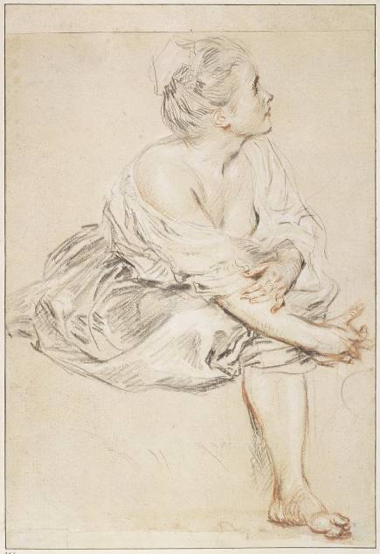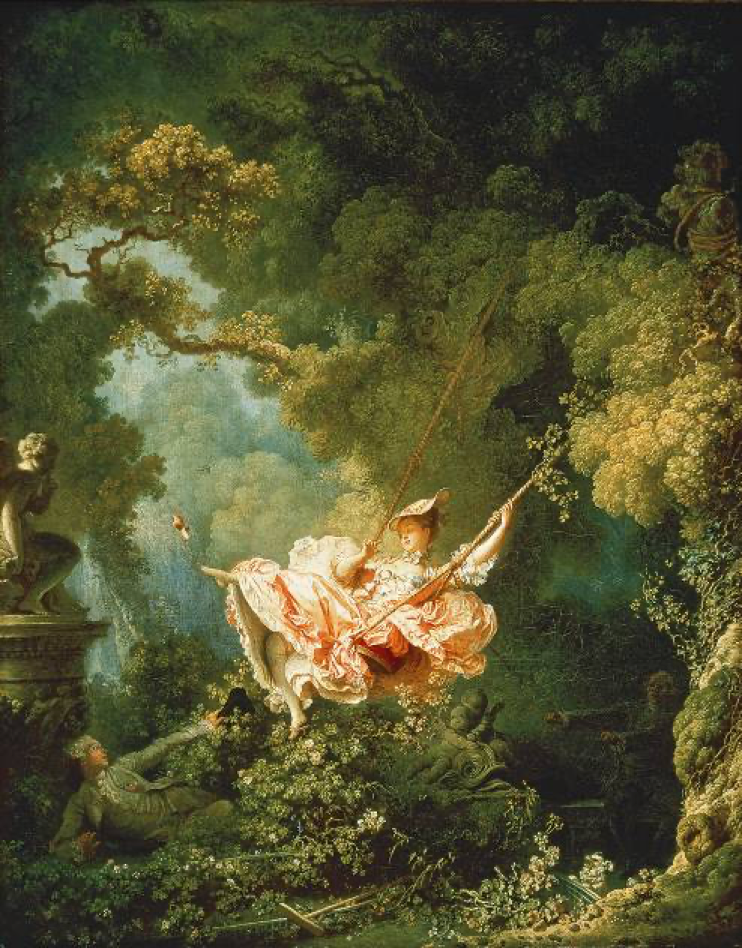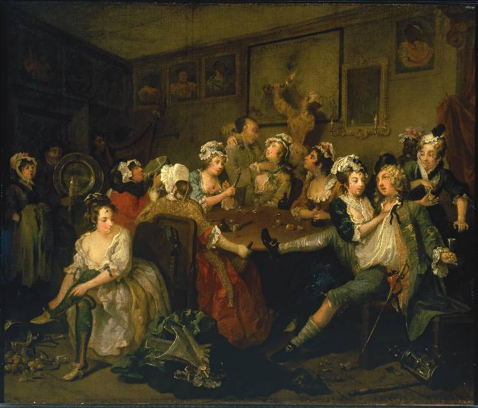11: Europe During the Rococo Period
- Page ID
- 219614
\( \newcommand{\vecs}[1]{\overset { \scriptstyle \rightharpoonup} {\mathbf{#1}} } \)
\( \newcommand{\vecd}[1]{\overset{-\!-\!\rightharpoonup}{\vphantom{a}\smash {#1}}} \)
\( \newcommand{\dsum}{\displaystyle\sum\limits} \)
\( \newcommand{\dint}{\displaystyle\int\limits} \)
\( \newcommand{\dlim}{\displaystyle\lim\limits} \)
\( \newcommand{\id}{\mathrm{id}}\) \( \newcommand{\Span}{\mathrm{span}}\)
( \newcommand{\kernel}{\mathrm{null}\,}\) \( \newcommand{\range}{\mathrm{range}\,}\)
\( \newcommand{\RealPart}{\mathrm{Re}}\) \( \newcommand{\ImaginaryPart}{\mathrm{Im}}\)
\( \newcommand{\Argument}{\mathrm{Arg}}\) \( \newcommand{\norm}[1]{\| #1 \|}\)
\( \newcommand{\inner}[2]{\langle #1, #2 \rangle}\)
\( \newcommand{\Span}{\mathrm{span}}\)
\( \newcommand{\id}{\mathrm{id}}\)
\( \newcommand{\Span}{\mathrm{span}}\)
\( \newcommand{\kernel}{\mathrm{null}\,}\)
\( \newcommand{\range}{\mathrm{range}\,}\)
\( \newcommand{\RealPart}{\mathrm{Re}}\)
\( \newcommand{\ImaginaryPart}{\mathrm{Im}}\)
\( \newcommand{\Argument}{\mathrm{Arg}}\)
\( \newcommand{\norm}[1]{\| #1 \|}\)
\( \newcommand{\inner}[2]{\langle #1, #2 \rangle}\)
\( \newcommand{\Span}{\mathrm{span}}\) \( \newcommand{\AA}{\unicode[.8,0]{x212B}}\)
\( \newcommand{\vectorA}[1]{\vec{#1}} % arrow\)
\( \newcommand{\vectorAt}[1]{\vec{\text{#1}}} % arrow\)
\( \newcommand{\vectorB}[1]{\overset { \scriptstyle \rightharpoonup} {\mathbf{#1}} } \)
\( \newcommand{\vectorC}[1]{\textbf{#1}} \)
\( \newcommand{\vectorD}[1]{\overrightarrow{#1}} \)
\( \newcommand{\vectorDt}[1]{\overrightarrow{\text{#1}}} \)
\( \newcommand{\vectE}[1]{\overset{-\!-\!\rightharpoonup}{\vphantom{a}\smash{\mathbf {#1}}}} \)
\( \newcommand{\vecs}[1]{\overset { \scriptstyle \rightharpoonup} {\mathbf{#1}} } \)
\( \newcommand{\vecd}[1]{\overset{-\!-\!\rightharpoonup}{\vphantom{a}\smash {#1}}} \)
\(\newcommand{\avec}{\mathbf a}\) \(\newcommand{\bvec}{\mathbf b}\) \(\newcommand{\cvec}{\mathbf c}\) \(\newcommand{\dvec}{\mathbf d}\) \(\newcommand{\dtil}{\widetilde{\mathbf d}}\) \(\newcommand{\evec}{\mathbf e}\) \(\newcommand{\fvec}{\mathbf f}\) \(\newcommand{\nvec}{\mathbf n}\) \(\newcommand{\pvec}{\mathbf p}\) \(\newcommand{\qvec}{\mathbf q}\) \(\newcommand{\svec}{\mathbf s}\) \(\newcommand{\tvec}{\mathbf t}\) \(\newcommand{\uvec}{\mathbf u}\) \(\newcommand{\vvec}{\mathbf v}\) \(\newcommand{\wvec}{\mathbf w}\) \(\newcommand{\xvec}{\mathbf x}\) \(\newcommand{\yvec}{\mathbf y}\) \(\newcommand{\zvec}{\mathbf z}\) \(\newcommand{\rvec}{\mathbf r}\) \(\newcommand{\mvec}{\mathbf m}\) \(\newcommand{\zerovec}{\mathbf 0}\) \(\newcommand{\onevec}{\mathbf 1}\) \(\newcommand{\real}{\mathbb R}\) \(\newcommand{\twovec}[2]{\left[\begin{array}{r}#1 \\ #2 \end{array}\right]}\) \(\newcommand{\ctwovec}[2]{\left[\begin{array}{c}#1 \\ #2 \end{array}\right]}\) \(\newcommand{\threevec}[3]{\left[\begin{array}{r}#1 \\ #2 \\ #3 \end{array}\right]}\) \(\newcommand{\cthreevec}[3]{\left[\begin{array}{c}#1 \\ #2 \\ #3 \end{array}\right]}\) \(\newcommand{\fourvec}[4]{\left[\begin{array}{r}#1 \\ #2 \\ #3 \\ #4 \end{array}\right]}\) \(\newcommand{\cfourvec}[4]{\left[\begin{array}{c}#1 \\ #2 \\ #3 \\ #4 \end{array}\right]}\) \(\newcommand{\fivevec}[5]{\left[\begin{array}{r}#1 \\ #2 \\ #3 \\ #4 \\ #5 \\ \end{array}\right]}\) \(\newcommand{\cfivevec}[5]{\left[\begin{array}{c}#1 \\ #2 \\ #3 \\ #4 \\ #5 \\ \end{array}\right]}\) \(\newcommand{\mattwo}[4]{\left[\begin{array}{rr}#1 \amp #2 \\ #3 \amp #4 \\ \end{array}\right]}\) \(\newcommand{\laspan}[1]{\text{Span}\{#1\}}\) \(\newcommand{\bcal}{\cal B}\) \(\newcommand{\ccal}{\cal C}\) \(\newcommand{\scal}{\cal S}\) \(\newcommand{\wcal}{\cal W}\) \(\newcommand{\ecal}{\cal E}\) \(\newcommand{\coords}[2]{\left\{#1\right\}_{#2}}\) \(\newcommand{\gray}[1]{\color{gray}{#1}}\) \(\newcommand{\lgray}[1]{\color{lightgray}{#1}}\) \(\newcommand{\rank}{\operatorname{rank}}\) \(\newcommand{\row}{\text{Row}}\) \(\newcommand{\col}{\text{Col}}\) \(\renewcommand{\row}{\text{Row}}\) \(\newcommand{\nul}{\text{Nul}}\) \(\newcommand{\var}{\text{Var}}\) \(\newcommand{\corr}{\text{corr}}\) \(\newcommand{\len}[1]{\left|#1\right|}\) \(\newcommand{\bbar}{\overline{\bvec}}\) \(\newcommand{\bhat}{\widehat{\bvec}}\) \(\newcommand{\bperp}{\bvec^\perp}\) \(\newcommand{\xhat}{\widehat{\xvec}}\) \(\newcommand{\vhat}{\widehat{\vvec}}\) \(\newcommand{\uhat}{\widehat{\uvec}}\) \(\newcommand{\what}{\widehat{\wvec}}\) \(\newcommand{\Sighat}{\widehat{\Sigma}}\) \(\newcommand{\lt}{<}\) \(\newcommand{\gt}{>}\) \(\newcommand{\amp}{&}\) \(\definecolor{fillinmathshade}{gray}{0.9}\)Introduction
The Rococo Period is a period in European art and culture dominated by the French aristocracy and court. Architectural designs explored during the Baroque Period are pushed to the limits much as the Gothic art style reached a point where the patterns, designs, and motifs became flamboyant and flame-like. We can see this tendency in design to push the limits of popular trends. In the American automobile designs of the 1950s, tail light fins became such a trend that peaked by the end of the decade and then slowly disappeared in the early 1960s. Art Nouveau lasted about 10 years and evolved into other related design trends such as Art Deco. So it is with the evolution of painting, sculpture, and architecture from the Renaissance through the Rococo.
In the buildings, we see a movement away from the last highly decorative Gothic ornamentation, to the austere and simple classical forms of Brunelleschi. The rebirth of these classical forms eventually evolve into more decorative styles that move away from rigid architectural orders. The Baroque uses architecture in highly creative ways and the Rococo pushes these trends to the limits, and at times in excessive fashion. The excesses of style reflect the excesses of the sensual pleasures afforded the wealthy French aristocrats and royalty. They have the leisure time and the money to explore hedonistic pleasures which they do in abundance. Woman are elevated to goddess status and are featured in playful and often erotic paintings. Fashions trends established by Louis XIV are popular among the French court and greatly influence the art produced at this time. The power of the monarchy is at its zenith, but time is running out for this type of political system. The excesses of the French elite will be tested and revolution will soon follow. Battle lines will be drawn in art circles as well as painters like Boucher create scandalous images of mistresses in provacative poses, and artists like Chardin attempt to show the everyday women bringing food home from Parisian markets. The cultural clashes play out in the paintings and resentment builds in the common men and women of France. This culminates in bread and other shortages and the traitor and outsider Marie Antoinette, wife of Louis XVI, famously quoted as saying "let them eat cake" in regards to the flour shortage. This was unlikely spoken by her, but in subsequent years appears to represent the sentiments the French had for her disregard for the French peasant class.
Drawing is an intellectual process involving thought processes including using sighting, unit of measure, proportion and scale, and keen observations. With a focus on color, painting can be more emotional and less technical and appeals to the senses. Arguments over the merits of both approaches have, from time to time, appear amongst artists and the Rococo is one time when the arguments are quite real. Poussinistes argued that the intellectual use of line (drawing) was superior and appreciated by the educated mind, while Rubenists argued that color, which engaged the senses, was the better direction. Watteau supported the ideas of the Rubenists and pushed forward the use of color and fantasy subject matter in his work.

A Pilgrimage to Cythera, Jean-Antoine Watteau 1717
If the Baroque emphasized theatricality, often on a grand scale, Rococo art favored fantasy and intimacy. Watteau presents a romantic world of fantasy in his painting A Pilgrimage to Cythera. Although similar to Rubens Gardens of Love, it creates a wistful world with a hint of melancholy and a gentle, quiet and slow dance through time and space. While not linked to specific literature, the title hints of the Greek myth of the birth of Aphrodite through the title. The focal point of the painting is the turn of the woman's head as she looks back at the two couples who linger behind. Cupids play with one another, as in Rubens' Baroque work and it seems as if time is standing still. The gathering of elegant couples on this island appear to be either ascending or descending the gentle slope towards the sea.
https://www.artic.edu/artworks/50234/pilgrimage-to-the-island-of-cythera

Seated Young Woman, Watteau 1716
Watteau's surviving drawings give us a glimpse into the academic studies of the human figure popular at that time. Much time was spent in the studios drawing from models both nude and clothed. Drapery with complex folds was also a subject to be mastered. In the drawing Seated Young Woman, we see the application of three types of drawing crayons similar to the Conté crayons developed by Nicolas-Jacques Conté in 1795 that are available for use today. Using three types of crayons (tois crayons technique), Watteau is able to capture subtleties in the subject. A paper with a value darker than white was needed to use the white crayon for accents and highlighting.

Gersaint’s Signboard, Watteau 1721
Giving us a look into the world of the wealthiest Parisians, Watteau paints an art gallery where the elegant women come to decorate their elaborate homes with the greatest art from the period. Some of the paintings are by the masters, including Velasquez. The two women in their elegant dresses are the focal points. The seated woman to the right casually rests her arm on the counter as she considers some of the items. The folds of her dress and the light reflecting off the material brings the focus up to her torso and turned head. Her dark overcoat is pushed aside revealing her beautiful dress. The woman to the left, with an equally impressive dress enters the gallery. Her head is impossibly small making her appear quite tall.
https://www.youtube.com/watch?v=qgq8iwhpGCI

The Toilet of Venus, François Boucher 1751
After the death of Watteau, Boucher rises in stature as the court painter to Madame de Pompadour. She is often referred to as the "godmother of the Rococo." She rises up in the royal court first as officially the Royal Mistress to Louis XV in 1746, and eventually named Lady in Waiting to the Queen at age 35. She support the arts and is also involved with court politics. The painting by Boucher titled Portrait of Madame de Pompadour from 1756 is similar to Ruben's Spinola portrait.
https://www.nga.gov/collection/artist-info.996.html
https://www.metmuseum.org/toah/hd/bouc/hd_bouc.htm
https://www.getty.edu/art/collection/person/103JVY
https://www.youtube.com/watch?v=lnJRkY0mZh4

The Swing, Jean-Honoré Fragonard 1767
Fragonard was a pupil of Boucher and in 1752 won the Rome prize in 1752. He pent five years studying on Rome before returning to serve the French royalty and aristocrats. His paintings sum up the Rococo spirit in France by emphasizing fantasy, the erotic, flirtation, and, in many cases, irreverence. The Swing shows a male catching a peek up the dress of his lover's dress while the bishop pushes the swinf totally unaware of the naughty game being played. Even Cupid raises his hand to place his finger over his mouth as a little visual play with the overall secrecy of the scene.
https://www.metmuseum.org/toah/hd/frag/hd_frag.htm
https://www.frick.org/art/artists/fragonard
https://www.youtube.com/watch?v=12CFokNNqDg

Back from the Market, Jean-Siméon Chardin 1739
Chardin's paintings are in stark contrast to the often frivolous paintings of Fragonard and Boucher. Chardin gives us a different look at everyday French living through interior scenes, moments in time, ans a focus on still-life. Chardin elevated the still-life genre whereby it becomes an acceptable entry into the Paris salon.
https://www.nationalgallery.org.uk/artists/jean-simeon-chardin
https://www.youtube.com/watch?v=ukiNmcyuhTA

Kitchen Still Life, Chardin 1733

Blowing Bubbles, Chardin 1733
https://www.metmuseum.org/art/collection/search/435888

Marie Antoinette and Her Children, Élizabeth-Louise Vigée-LeBrun
Vigée-LeBrun paints Marie Antoinette as a mother who has endured tragedy. her son pulls back the dark veil covering the crib of his deceased sibling, while Marie presents herself as the center of the family with her adoring children at her side. Marie, France's last queen, lived a lavish lifestyle drawing the anger of many. She was later executed and her young son died while imprisoned.
https://www.nationalgallery.org.uk/paintings/international-womens-day-elisabeth-louise-vigee-le-brun
https://www.metmuseum.org/toah/hd/vgee/hd_vgee.htm
https://www.biography.com/royalty/marie-antoinette-children-louis-charles-marie-therese

Room in the Hôtel de Varengeville, Nicolas Pineau 1735
Nicolas Pineau's Rococo designed interior survives at 217 Boulevard Street-Germain in Paris. This is one of just a few interiors that have not been remodeled over the years. The design is overly exuberant with gold guilded carved oak and painted surfaces.

Nymph and Satyr Carousing, Claud Michel (known as Clodon) 1780
https://www.getty.edu/art/collection/person/103K0R


The Orgy, Scene III of the Rake’s Progress, William Hogarth 1734
Sequential art is very popular today through comics, manga, and anime. The beginning of sequential art can be debated, however, in the modern world we first see this in the printed series focused on modern moral subjects by William Hogarth titled A Harlot's Progress and later A Rake's Progress. Etchings made from Hogarth's paintings allowed mass production prints that were distributed to an appreciative audience.
https://www.nationalgallery.org.uk/artists/william-hogarth

Robert Andrews and His Wife, Thomas Gainsborough 1748-1750
https://www.nationalgallery.org.uk/paintings/thomas-gainsborough-mr-and-mrs-andrews
https://www.nationalgallery.org.uk/artists/thomas-gainsborough
https://www.tate.org.uk/art/artists/thomas-gainsborough-199

Mrs. Siddons, Gainsborough 1785
Thomas Gainsborough painted in a style that captured the elegance of his patrons. Much like Frans Hals whose loose brushwork and ability to capture a feeling, emotion, and life in his paintings gained him many admirers, Gainsborough also created a casual elegance that has stood the test of time. His paintings are often compared with his rival Sir Joshua Reynolds whose formulaic approach was more academic.
https://www.nationalgallery.org.uk/paintings/thomas-gainsborough-mrs-siddons

Mrs. Siddons as the Tragic Muse, Sir Joshua Reynolds 1784
https://smarthistory.org/reynolds-siddons-tragic-muse/
https://artmuseum.princeton.edu/collections/objects/10851
Charles LeBrun played a major role as an educator and administrator of the French Royal Academy. In England, Joshua Reynolds helped establish the Royal Academy of Art in 1768. He was appointed president of the newly founded academy by George III. Classically trained, he greatly improved the level of art instruction in England by instituting a rigorous study of specific art techniques based on classical themes, historical painting, and Grand Manner portraiture. Portraiture was where the money was since there was a high demand for this art genre and less commissions for larger historical paintings. Reynolds studied in Rome from 1750-52 and returned to London well-equipped to lead this art movement in England.


